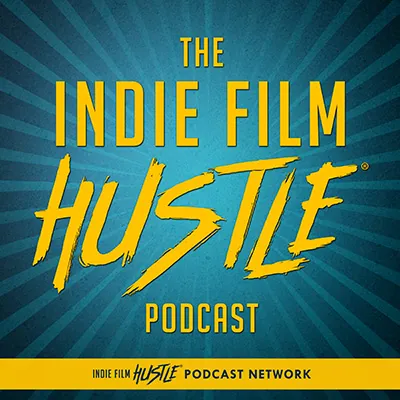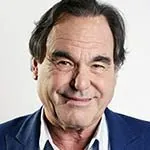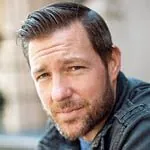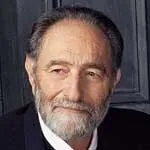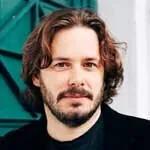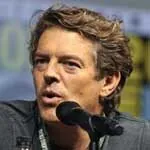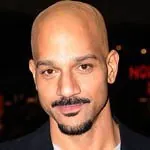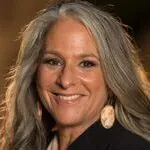Today, my guest is a prolific cinematographer, accomplished photographer, and member of the American Society of Cinematographers, Dean Cundey A.S.C.
Dean rose to fame for extraordinary cinematography in the 1980s and 1990s. His early start was working on the set of Halloween. Dean is credited as director of photography on five Back To The Future films and Jurassic Park.
The Halloween slasher franchise consisted of eleven films and was initially released in 1978. The films primarily focus on Michael Myers, who was committed to a sanitarium as a child for the murder of his sister, Judith Myers. Fifteen years later, he escapes to stalk and kill the people of the fictional town of Haddonfield, Illinois. Michael’s killings occur on the holiday of Halloween, on which all of the films primarily take place.
The second film, one of which Cundey served as director of photography, was based on Marty McFly, who had only just gotten back from the past when he is once again picked up by Dr. Emmett Brown and sent through time to the future. Marty’s job in the future is to pose as his son to prevent him from being thrown in prison. Unfortunately, things get worse when the future changes the present.
The three Back To The Future films Dean worked on grossed $388.8, $336, and $243 million globally, becoming all-time hits on budgets of $19, $40, and $40 million.
Cundey is cited as being amongst some of the best directors of photography. In addition to his lighting skills, particularly in the famous hallway scene where the hidden face of Michael Myers, played by writer/director Nick Castle, is slowly revealed by way of a blue light next to the mask, he was among the first cinematographers to make use of a recent invention called the Steadicam, or paraglide.
Some other shows and movies he’s worked on include, Who Framed Roger Rabbit, Tales of the Unexpected, Romancing the Stone, Invitation To Hell, Big Trouble in Little China, etc.
Who Framed Roger Rabbit; A toon-hating detective is a cartoon rabbit’s only hoping to prove his innocence when he is accused of murder. Basically, ‘Toon star Roger is worried that his wife Jessica is playing pattycake with someone else, so the studio hires detective Eddie Valiant to snoop on her. But the stakes are quickly raised when Marvin Acme is found dead, and Roger is the prime suspect. Groundbreaking interaction between the live and animated characters, and lots of references to classic animation.
Dean grew up an avid reader of the American Cinematographer magazines he would buy after school from a local camera shop close by. That was how his inspiration to pursue filmmaking came about. He shifted his focus to theater history while still taking some architectural design classes at California State University before he ultimately enrolled at the University of California Los Angeles film school.
In 1993 Jurassic Park, Dean made a minor appearance as a boat crew member (Mate) while also staffed as director of photography. The film follows a pragmatic paleontologist visiting an almost complete theme park tasked with protecting a couple of kids after a power failure causes the park’s cloned dinosaurs to run loose. Huge advancements in scientific technology have enabled a mogul to create an island full of living dinosaurs. A park employee attempts to steal dinosaur embryos, critical security systems are shut down, and it now becomes a race for survival with dinosaurs roaming freely over the island.
Cundey holds over one hundred and fifty cinematography & photography credits for movies, television, and short films. That is no small feat in this business. The man has stayed busy and booked since graduation from film school. That kind of consistency in Hollywood is only doable by having extreme persistence and excellence.
One of the many things he did to stay prepared and on top of his craft was investing into building himself a ‘super van’ or one couple call it a cinematographer’s heaven that contained every equipment (cameras, editings tools, etc.) required to help him get work get and do work easily.
We talk more about Dean joining The Book of Boba and The Mandalorian crew as well. Check it all out in our chat.
Enjoy my conversation with Dean Cundey.
Right-click here to download the MP3
Alex Ferrari 0:16
I'd like to welcome to the show Dean Cundey. How you doing Dean?
Dean Cundey 0:19
Very good. How are you?
Alex Ferrari 0:22
I'm doing very good. I want to thank you so much for coming on the show. I've, I mean, you. I'm sure you hear this all the time, but you shot my childhood?
Dean Cundey 0:35
Well, yes, you know, what, it's, it's a intriguing, oh, it's off, go to a convention, or I'll meet people and they'll say, Oh, you know, I, it was the first film my father, let me watch or whatever, for Jurassic Park, for instance. Sure. And, you know, it, it kind of puts in perspective, the fact that, that I'm old, and the end, because a lot of the people who say they loved the film, say, you know, was from their childhood or something. And, and I, you know, it wasn't from my childhood, I was, I was older, by the time I was shooting those things. So right, but I'm glad glad to see that the the audience has, I don't know, spread to like three generations. So, you know, to know that I've touched in some way that many people is is very satisfying.
Alex Ferrari 1:43
Yeah, absolutely. And one film that that I'm sure you don't get talked about a lot, but it's one of I think the first time I ever saw your work was because when it when it came out, I saw it, which was a little film called DC cab. Back in the day, the the Mr. T movie, The Joe Schumacher film, I adore that film.
Dean Cundey 2:06
No one I haven't seen it in, in so long. And it was was a lot of fun working on it, because it was an interesting ensemble cast. Besides your tea, you know, there was there was Bill Maher, you know, various people. So Mara has left acting, and now is doing a major TV news show where he does a lot of acting.
Alex Ferrari 2:36
There's that. So can you tell the audience? How do you got into the business?
Dean Cundey 2:43
Well, I wanted to be in the business since I was like 10 years old. And I was fascinated by movies, fascinated by how they could take you on these journeys to places you can't go in real life, you know, but it wasn't just about stories. It wasn't just about being a fan. It was about these, the people who were making these films that would fool us that made us think we were on this journey make make us think we were visiting that place or that time. And I was I was intrigued by the fact that there were people with these skills and this artistry that that could do that. And I want to educate I was interested in magic. I used to do magic shows for kids birthday parties, and like all my relatives and friends. And and I think what intrigued me about magic was fooling people into thinking something's happening that isn't really it. And I was privileged to be behind the scenes because I was the magician. And I think I associated that kind of magic with the magic of film, The Magicians of film who were doing, you know, just regular sort of mechanical things. But when it ended up on the screen, it was a whole experience for the viewer. And I was fascinated by that aspect of the magic and the storytelling. So I I went to film school. I was fascinated all through high school. So I decided to go to film school, UCLA. And then when I graduated, I was I guess very fortunate. Because I know a lot of my friends who graduated then were scrounging and looking for work. And one of my friends at UCLA had convinced Roger Corman, the Paramus low budget filmmaker to let them Do a motorcycle gang movie. And Bruce well, who was the director, he had. He had the wisdom and the and all that to invite all of his filmmaking fellow students that he could get on the film into working on it. And one of the last jobs that was left because I was interested in cinematography, but one of the last jobs left was makeup. And I had done some makeup on a couple of their student films, which is why they may have taught me. So as a result, if I was doing makeup on the naked angels. And then after that film wrapped, Roger Corman called me up and said, he wanted me to do makeup on a film, he was directing. And I thought, wow, this is pretty cool, you get out of film school, and you immediately start working in movies. But after that film, it stopped. I faced the reality of having to get another job. And so I, I just began taking any job I could get, I did some special effects. I did some second camera operating, I did, you know, just a whole variety of things that were all all about. making contact with people and getting experience and establishing a reputation of some kind. So I, I was lucky. At first, it was very intermittent work, but I, I didn't have to go and get a job as a waiter or something like that. Because I've seen people who get diverted. You know, I know young lady who is a brilliant makeup artist who, who had to get another job because, you know, she was missing a period of time of work. And now she's been diverted down this way of working like regular people do.
I didn't want to do that. I wanted to stick it out and try to stay in the film business. And, and fortunately, I was able to scrounge enough work to get buy in, over a period of time it grew and grew. And then suddenly, I had a bunch of work.
Alex Ferrari 7:47
That that's the way Yeah, it's a normal, you just don't walk out of film school, and they just hand you jobs. Yeah. Even even in today's world, let alone back then as well. Well, you know,
Dean Cundey 7:58
and, and that's, that's one of those things that with real world people, you know, they, there's, there's not a lot of people who understand that they get out of school, and they. And they just want a job. So they go get one and they're happy. Others who are studying law and accounting, and they can do entry level jobs. Excuse me, they can do entry level jobs of just pushing paper and filing things and in their, their chosen field, accounting or law or whatever. And as a result, they can sort of work their way up a ladder, and film his film is very unusual, from that standpoint, that you never know where your next job is coming from, no matter what, what level you climbed to, you know, and same with everybody in the business. I mean, famous actors, you know, who don't know what their next film is going to be. Because even though they may have offers, who knows if the film is going to fall through, and they're not going to get paid their $20 million. So you're right. It's an unusual business
Alex Ferrari 9:21
very much. So. Now, you worked with john Carpenter on probably, I think five films. And the first one that you worked with him on which was Halloween. What did you think of the fluid prowling camera or the or as we like we call it now the steady cam. You were one of the first to really use it, especially in the way you and john envisioned using it. What was that like?
Dean Cundey 9:47
Well, I'll tell you, it was very, very intriguing, rewarding. The steady cam had sort of just been invented, right? And it was being used as, as another camera to shoot a shot of, you know, walking through a crowd or something like that. But nobody had seen it as a, an entire technique. And john and i had decided that it could become a character, it could become the eyes of the audience. creeping through this world, it could be the eyes of Michael Myers, it could be us watching Michael Myers, and moving, giving the audience more of an immersion into the story, and the movie. And then previously, you know, yeah, they've been using handheld cameras, and you put the camera on your shoulder, but as you walk, the camera moves with your body. And it it, to me, it's always sort of distracting because that's not how we see the world in real life, how our eye and our brain compensates for all of this body movement, and our impression is smooth and, you know, continuous movement through life. I like to point out the fact that our life is one long steady cam shot very much with no cuts, with the exception of when we go to sleep. But it so john, I thought what a What an interesting tool because it was not handheld, it did not call attention to the camera. It was smooth. And you really, as an audience member felt that you were, you know, a participant in the in the scene or the story.
Alex Ferrari 11:49
And it was very eerie. It was just kind of this eeriness because it's something you hadn't seen before. I think I think rocky had used it. And then obviously Stanley used it as Mr. Kubrick used it in the shining, to great avail, as well, but you were the first to kind of make it a character which was, again, very off putting, especially with his John's music.
Dean Cundey 12:10
Oh, yeah, no, it was, you know, the combination of the music, the camera, the moving the story, the you know, the lurking Michael Myers who never spoke. You didn't see him as, as a person that was a force. And so. And I think all of that newness was one of the reasons that the first week it came out, it was not like, popular because they didn't have the huge amount of publicity, they can invest in a film now. It just sort of came out in the first week there were people who came and, but not very many, and everyone thought, Well, I guess the film is not a success. But the second week, more people came third week more people and kept doubling. And, and I think that was the proof that the the audience appreciated all of this new creepiness that we were able to do with the steady cam. And you know, John's music, you know, it's off putting five four meter instead of what you were used to hearing and music. And, you know, it was a combination of all the right things at the right place at the right time.
Alex Ferrari 13:41
Now, what were some of your biggest challenges or unexpected surprises when you were filming? films like The thing and Escape from New York?
Dean Cundey 13:52
Well, I I always look at Escape from New York is one of one of my most intriguing and interesting projects because it was it was it was a world that didn't exist, you know, New York is a prison and it had its own character, you know, that shabbiness the desolate, you know, feeling and the fact that the red light things with fires instead of electric lights. So it was a creating of an entire world that at the same time was feasible. It was not even though it was in the future. It could be Now it could be some parts of a town, you know, so it was identifiable in that way for an audience. And yet, it was completely, you know, bizarre world. So I think that was a lot of the interest They'll appeal to it for me, creating that dystopian world.
Alex Ferrari 15:06
Now, when you worked on what what I mean, when you've worked on Back to the Future, how did you pivot your, your, your technique, your working style when it came to, you know, visual effects, because visual effects had just started to really come into their own. And I mean, obviously the Star Wars films and, and other things like that, but Back to the Future had a good amount of visual effects. How did you approach that was that was that kind of your first big visual effects, heavy film, or was there one prior to that?
Dean Cundey 15:40
Well, visual effects were creeping in. And early on, we were lucky to do one, to have the experience of creating some kind of illusion. And then, over a period of time, they became more and more important till now the effects drives a movie all these superhero movies and stuff. But I didn't know I think that was one of the things I always felt was that I didn't want to get typed into a particular kind of movie. I didn't want to become the adventure the the romantic comedy guys, or whatever. So I deliberately would take different kinds of films, even though I was offered a better job on another horror film, I would, I would look for something different, so that I could learn, learn and experience different techniques of storytelling. So that I wouldn't be doing the same thing over and over again, darkness that is horrifying, or whatever. And so I, I've always looked for different things. And and I've always enjoyed, as I say, the magic, the creating of different worlds and stories and stuff. And, and so I've always been drawn to different kinds of films that you know, that that had interesting. potential new techniques, new visual effects, techniques, new storytelling techniques. And all of that is, it's, I think, what keeps one alive and fresh in the business as opposed to, you know, I, I know, friends who have done, oh, seven or eight years of the same TV show. And they, and they say, you know, it was it was great at first. And then and then it became the same thing over and over, but they kept offering me more money or something. And so I caved into it as a job. And I, I've always hated to be get into that position where you're doing it just as a job it has to be creatively involving.
Alex Ferrari 18:16
Now what you you had a very unique experience with Back to the Future because you got to do something that a lot of cinematographers would love to be able to do, which is sometimes go back six weeks and reshoot things, and maybe shoot things differently than you might have shot the first time. Because it's, you know, obviously the lore is not the Lord but the facts are that they shot six weeks of back the future with Eric Stoltz in the in the in the starring role, and then Robert and Steven and everyone pulled back and said, No, I think we need Michael J. Fox. So you had to go back and shoot a lot of those scenes again, did you change some of your lighting techniques or lighting style? Did you like, take that opportunity? How, what was that? First of all, when they said that to you? What did you say?
Dean Cundey 19:00
Well, you know, sometimes we'll go back and reshoot a scene chart on some movie for a particular reason. A director didn't like the performance, the special effects didn't work. It they, they changed the location, it's no longer a factory it now it's so young, you know, somebody's bedroom or whatever. So in those cases, you you do something different. But when we we looked at the first six weeks of Back to the Future, and the opportunity was there to reshoot. did much of it is I wanted, I said to Steven, whoa, what do you think? And he came to me and he said, Listen, I love the way it is and It looks don't change anything, do it exactly the same way. And we'll just improve certain aspects. So I, I was very flattered by that. And so very often we would look at a little clip, we would have these pieces of film that would be three or four frames, and a little viewer, and we could put the film in there and look at it and and then say, Yes, okay, we had a light back there. Put that over there, you know, and, and we would recreate it, you know, the same way because apparently, Steven and Bob and everybody loved it.
Alex Ferrari 20:45
That's awesome. Now I have to ask you, the the fire, the fire, the tire fire marks that are left by the DeLorean. That was practically shot and composited afterwards, correct?
Dean Cundey 21:00
Yeah, in some cases, practically shot right at the location, the, the shopping mall, the street in eduniversal, when, when the when doc is jumping around, and he's returning to the. And I think that one of the things that really, you know, those of us in the business we can look at and say, Oh, look at that they composite at the fire in there. It's not very good, or Oh, they did a great job, whatever. But what one of the things I think is anytime you can do it, practically, there's a certain feeling that the audience will have that they're seeing it actually happen, no matter how good the CG animation or whatever. And in the case of the firecracker, they had built a special device was a dolly with two nozzles spaced apart the distance of the tires, and a big tank of flammable fuel. And they would push it along, and it would lay down this these streaks of flammable liquid. And then they would pull the card out of frame light to fire and it would burn and it was bad. And it and it was it was awesome to watch. But also, we knew that it was going to look like what it was supposed to be burning fire tracks so so sometimes you don't want to do it by the so called easy way. You know, there's turning it over to some a effects guy who will work on a computer. Sometimes you want to do it as practically as you can and and devise a way to do it. And it was an ingenious solution.
Alex Ferrari 23:08
Did you speed it up in the camera?
Dean Cundey 23:11
No, we we shot it regular speed so that it looked? You know, real so the flame movement was?
Alex Ferrari 23:19
Yeah. I didn't think about I was only thinking about the really I didn't even think about the flame movement. You're absolutely right. Now, another film that you did, Who Framed Roger Rabbit? Technically, must have been enormous because no one had ever done anything like that before. And not that way, at least not with that many characters and things before. How did you light for a cartoon that was just in the frame?
Dean Cundey 23:52
Well, we were concerned at first because it was cel animation that was painted on the back. So it's flat characters. And nobody had done three dimensional lighting on flat characters before that had always been there. If you look at Disney films, there's a suggestion of shadows in the paint. But it always looks flat. And for that reason, the lighting has to be very flat and even. And the camera work has to be wide and stationary. You're not in those days, you weren't able to pan and follow a composite character. And so when we were given those rules, we said whoa, those are the rules we're going to break. And we we devised ways and ILM, Ken Ralston was was great in coming up with a technique where they could take the flat enemy And then add highlights and shadows that matched the lighting. So I was not restricted to flat lighting, but could do it just in a way that looked, you know, normal, so to speak. And it it made it much easier to to create this world and then not knowing that they were going to add these characters and so that they, they would blend in and it it worked very well. One of my favorite projects ever.
Alex Ferrari 25:35
Yeah, I wish they would have made the sequel. wish they would have made this.
Dean Cundey 25:40
You know, they had tried the ideas for for the sequel, but they could never get everyone to, to agree. Unfortunately.
Alex Ferrari 25:51
Yeah, that was a I mean, for everyone listening, if you haven't seen Roger Rabbit, you have to watch it because it's, it's unheard of. I mean, Disney Warner Brothers and a million other companies gave license to their best characters all for one movie. And that's just Yeah, it's a miracle that even came that even happened?
Dean Cundey 26:08
Well, that famous standing shot where they all burst in from Toontown into the factory. You look there, and there's almost any character that's ever been in an animated cartoon or world with the exception of one character, Coco, pop by you, right?
Alex Ferrari 26:31
I wasn't in that she,
Dean Cundey 26:35
what's her name? Fleischer. Anyway, she wouldn't allow Popeye to be used in this movie with all these other people. And as a result, everybody else is famous, and Maurice Popeye, you know, kind of an oversight in my estimation. Absolutely.
Alex Ferrari 26:54
Now, when you when you approach working with a director, what is what is how do you approach pre production with a director? And how should a cinematographer approach pre production with the director in your opinion? Well,
Dean Cundey 27:13
I think it all starts with, of course, reading the script, visualizing in my mind, which is separate from anybody else at that point. visualizing what that story looks like, a location can be described on the other page, but may not at all be where you're actually going to shoot it, or what the production designer comes up with, or how the director visualizes it. So I know that early on in my career, when I was doing these low budget shows, I would take the script and I would, you know, make notes on it. And I and the opposite the facing page, the back of the previous page, which is all blank, I would go a little sketches of how the camera could move or where the light might come from or something. And then I would be discouraged. Because as we would then begin pre production we would find out that we were being driven to look at the location that was a factory. And I'm going to say well, that's that's odd here in this script, it says restaurant and I had seen it in the kitchen. Oh, no, no, no, they couldn't get the restaurant but also they thought it would be scarier in the factory and oh, okay, so all my thought process and work and lead was all for not so I began to less and less make notes beforehand and learn to absorb you go to the director and say how do you see this scene or this whole movie? Is it bright and cheery is a dark and gloomy is it whatever. And then we would go to locations and and as we found out which location we were actually going to shoot in then I could start to visualize the camera and lighting and all that kind of stuff. So it's it was an evolving process. And it still is I still I like to give the production designer and freedom to create, you know, and not go and say make sure that this place has plenty of windows for lighting. Right. So now you're imposing something on his creativity. So I A lot of times, I will. I will wait to see what's happening. Look at the production designers plans. Then on bigger shows they'll build a model of the set You know, out of cardboard, but just so you can see the space and so forth. And, and I'd look at that and say, you know, it'd be good as we could put one more window over here, because then that would light it for because the scene is that he goes over to the safe and opens it up, and we can light. Okay, that's a good idea. So you hope that that everybody will respond to your wishes to the same way that I would respond to everybody else's desires and creative instinct.
Alex Ferrari 30:41
Now you were able to shoot two films with Mr. Steven Spielberg. The first one, still one of my favorite films of the 90s. Again, one of those films I grew up with, and absolutely adored a hook that came out, it was so beautiful, you know, you go into the world of hook and you just are lost in this rabbit hole that you kind of go down? How did you? First of all know, that was Alice in Wonderland, though? I know. I know. I know, I know. I know, I'm mixing I'm mixing my my
Dean Cundey 31:22
metaphors. Yes.
Alex Ferrari 31:24
But how did you approach lighting, such a massive set? Because it was like, I remember seeing the behind the scenes. And I talked to Jim Hart, who's been on the show, and everybody was visiting that set. It was like what it was the place to visit. It was like the tourist attraction of Hollywood. At the time, everybody wanted to see this massive set, how did you approach these large wide shot, you know, action sequences with that massive set?
Dean Cundey 31:52
Well, you know what, it was one of those things because I had people come to this Ted dp who looked at and said, Oh, my gosh, you would have no idea how to light this. I'm only the data. But I didn't want I didn't want anyone to know that. Because you know, you it's like painting, you know, painting with light is the cliche metaphor. And so you say, Well, okay, here's the big giant set with the, the pirate ship and the towel and everything. How would I light it? And you don't look at it from an overall standpoint, you say, Well, okay, so overall, like to, from the overhead, but that surface back there looks really interesting work. And I put a light out of frame that will light that all those windows are really interesting. So it's a bit some pieces, your bits and pieces, and I would go and look at the set. And make note, you know, before it was finished, so that when it came time to rig the lighting, you know, there was at least some kind of a plan. But and, and a lot of it was stylistic from the standpoint of what Stephen wanted. Originally, Neverland and the island was supposed to be shot. There. We're thinking in the Caribbean somewhere. Real Island, or maybe Hawaii. But then Stephen started to think no, the film really could be more theatrical. It shouldn't look too real. If it looks real, it's going to take away from the imagination. So he opted to do everything on sets that were constructed. Some of them at MGM or Sony, some universal. And the, the thing that came out of that was how to, you know, give us a sense of reality, but also a little bit of a theatrical feeling, and then met imagination. And so he and I began looking at various movies that were jungles that were lit locations that were artificial. And as we looked, there were particular ones. I think it was Tarzan, the early version of version one where it was obvious that there was lip and he said notice how it's all hot backlight just hitting the leaves, but the front is always no matter which way you look, the front is always pleasant. So maybe we can do something I said, Yes, perfect. So that's what we did, we would, you know, create over expose the light so that it didn't look to control on the on the jungle, but then properly light are our heroes, and it gave that theatrical sort of feeling to that.
Alex Ferrari 35:31
Now I have to ask you, what is it like collaborating with Steven Spielberg as a director and director of photography, because I know you'd worked with him on on other projects that he'd produced, like Back to the Future and so on. But this was your first time working with him in that creative relationship? What was that like?
Dean Cundey 35:50
Well, I know it was appreciated, Steven from the first things we saw jaws and so forth, the fact that he was a great and still is a great visual storyteller, he knows how to, to use the camera, but also stage actors stage action, so that it tells you exactly what you want to know, or need to feel at any particular moment in the film. So I had always appreciated that about him, and was just delighted when I had the opportunity to work with him and experience firsthand his his amazing talent for, for doing that visual storytelling. And so in, in hook I, because I think that was always my approach, even from low budget days, I would try to talk directors into some kind of interesting angle that would combine elements of action or whatever. And it was frustrating, because many of them thought of, of the camera as a device for recording actors talking, and then the exposure. And, and it was good, because of that frustration that I you know, I was delighted when I had a chance to work with, with Steven and, and had a chance to work with Steven then the experience his creativity, but also realized that I was encouraged that add to a suggestion, an embellishment, you know, a little different something. And so I very much appreciated that opportunity to work with him, and was delighted when I was invited to do Jurassic Park, which is one of the one of the, you know, his most successful movies, but also one of the most visually stimulating, I think,
Alex Ferrari 38:16
yeah, and it wasn't without question I was going to get to next was going to be Jurassic Park. I mean, there's, you know, the story goes that Phil Tippett was going to do stop motion originally for the dinosaurs. And they had gone down that path quite a bit until ILM, some ruffians over and ILM said, Hey, wait a minute, we could do something. And they showed it. And then Stephen said, we're, we're gonna go this way, when he had that comic, because this is such a pivotal moment in film history. This is the first time a digital character is, is inserted into a film in a massive way. Not one little character like they did in young Sherlock Holmes, I remember very realistic
Dean Cundey 38:59
way. Yeah, it was the challenge, obviously, really, ashore, all of our images of, of dinosaurs are, you know, skeletons in museums and artists. Right. So the fact that we were going to try to create these dinosaurs that that that had a realistic look, that you could believe they were actually existing in the world of the characters. So that was, that was a great deal of challenge but satisfaction. And, and it was, was fascinating because I had started on their film, prepping, when when I was going to be the stop motion, right? And then at a meeting right in the beginning, and then prep, Dennis mirror and from ILM came to the meeting and said, you know, we think we can create these creatures in the computer. And Steven said, fabulous slavery, show me Show me what you got. And they said, Well, we don't have anything yet. But we're working on it. I'll be right back. And he came back a week later, and said, Well, here's what we have, and showed the famous walking T rex skeleton. That was very convincing, because it has a sense of weight, you know, because of Phil Tippett's great animation, the tail movement, the way their head, barbed, all of that was was something that was a result of the work you could do on the computer, you want to stop motion, you have to photograph it. And then you look at the film and say, Oh, the head didn't Bob right? Or look jerky, or turn too quickly, or it doesn't look like it has weight. And, you know, with a computer, you can do the animation and then look at it immediately and say, Oh, yeah, the head movement is too fast. And you can go back and slow it down. And then you can face the way the tail is moving. And then the way the body moves up and down, and you know, and it's a process of being able to develop and refine the animation as it's being done. And it's, it's been one of the greatest sort of unseen aspects of computer animation is, you know, as an audience, you see it when it's finished. But when you are, you know, making it you look at the shots and scenes and say, Oh, yeah, that works. Oh, that doesn't. And, and you can fix
Alex Ferrari 41:57
it. How did you how did Were you a part of lighting it digitally, because that was the first time you were there was even digital lighting, like when they were lighting. So because the T rex has to match your lighting on set and so on.
Dean Cundey 42:10
Right. lighting in the computer is a completely different technology technique. We deal with physical lights that produce a certain amount of light, and then certain spread and distance and, and the they can create light that doesn't doesn't obey the rules of physics. So what what I did was, any time there's going to be a computer animated dinosaur, we took one of the animatronic ones, one of the puppets, and put it in that place, and I would light it. And then they would replicate that look in the computer. So I was lighting the computer stuff practically on the set. And they were, you know, making that happen in the computer.
Alex Ferrari 43:13
were they using the reflector balls at that point yet, like that big ball that reflects all the lights so they can have kind of a reference of where the lights are coming from, at that point or not yet.
Dean Cundey 43:24
It was sort of being developed at the time. And, you know, when they first brought it out, I thought What's this all about? And then it became evident? Yo, yes, I see. They're using a way to capture the information about where the lights are coming from and so forth, not just the intensity and they're not just painting with the, with the light, like you might do in Photoshop or something. They were in fact, finding where to put their lights, even though their digital lights and don't exist, finding ways to replicate what we were doing.
Alex Ferrari 44:12
Now, you also shot a film called Apollo 13, which is another one of my favorites Ron Howard's masterpiece film, some very interesting cinematography techniques in that film because you guys were wanting to get weightlessness in a way that no one had ever shot it before. And from what I seen and unseen behind the scenes, there was something called the vomit comet, where they would take the the actors they built a set on on inside of an aeroplane that will go up and down. And that little moment when they would drop, you would have like 45 seconds or a minute or something like that of weightlessness where you
Dean Cundey 44:48
wanted. 23 seconds.
Alex Ferrari 44:50
23 So were you were you on that vomit comet?
Dean Cundey 44:54
No sadly, I I went on another one later, yesterday. I've experienced weightlessness without spending a billion dollars Jeff Bezos has, yes. For his four minutes of weightless I've, I've made it for free, too. But but it was I, I look at Apollo 13 as an opportunity, because Ron Howard came to me and said, You know, I've never done special effects. So I'll be looking for guidance and stuff. And so we, we watched actual weightless footage that had been done in the early moon attempts. And instead, what is what are the characteristics that, that make it look real. And it was things like they, the capsule would always rotate in space, slowly, so that the sunlight wasn't always on one side, it would evenly heat and, and cool because the extremes from one side to the shadow side were extreme. And so there would be this capsule rotation. The there was the waitlist, the fact that our perception of people watching on TV, was the fact that the camera, we preserve video camera was really just floating itself. And there was a little movement in it. And so we look for those kinds of, of artifacts, you might say. And then I said, Well, how can I replicate that. So the capsule we had was stationary on a stage. So I devised this way with a moving light on the end of a crane arm, and it would move slowly around the capital, but we would always keep the light aimed into the window. We're using this rock and roll light. And in that way, the lighting inside the capsule was always sort of moving. And you know, it was a case of trying to coordinate that with with each setup so that it kind of matched. But it was a subtle, subtle way of saying this capsule was you know, somewhere else. And the same with, you know, various other things we we we created what we call teeter totters, that were a seat on this arm that would move just like a teeter tottering kids playground thing. And then I had them build the Capitol. So it could be rotated and hung in any position. So the bottom where the floor was on the bottom, then the floor would be on the top and then so what that did was it gave us a chance to move people on these teeter totters in in amongst the seats and they could you know rise up to the ceiling touch it and push themselves down and you know, subtle subtle things like that that you know we're not big story moments but they were just the ways the guys had to react and then we shot a lot of that then with the full figure weightless stuff that they shot going through the tunnel you know, various little things like that. And the the fact that the there's a sequence where they broadcast back to Earth all of the things that they're doing and the problems are confronting and on and that was a way of creating this full figured weightlessness and and artifacts and the moving light and all that just became secondary second nature to all of the story and the characters later in in a way that you know the audience believe they saw weightless all the time.
Alex Ferrari 49:40
Yeah, it was it was a wonderful trick like you said you were a magician and you Enron working together got that I didn't think I didn't know about the teeter totter that teeter totter it because he I just thought everything was shot in the vomit comment on like, My God, those poor guys
Dean Cundey 49:56
would have been very aptly named. For all of the crews reaction vomiting all the time.
Alex Ferrari 50:04
Now you you recently worked on a new show that's coming out in I guess I think it's coming out in December sometime, which is the book of Boba Fett. And I know you can you can't say anything about story of course but you got to shoot very quiet I know that everyone dies at the end I understand. But how did you approach lighting in the volume because that's such a new technology. I haven't had a chance to speak to anyone who's who's actually lit in that volume in where they shot Mandalorian and things how do you approach lighting in that world?
Dean Cundey 50:40
So Well, I'm going back Monday to the next season of the Mandalorian nice and and I guess I guess I'll find out how I did it. But it's it's interesting because the volume is this stage that has a giant die or Rama all around it have LED screen the giant TV screen that's 25 feet high by 775 feet across and it wraps around completely and so there it brings its own rules how close you can get to camera how you how you can move it No. So you have to learn those rules and then the lighting you know you're typically you're lighting a small area in the middle of the stage that is the set that is the the fire lit desert that they're sitting in and talking or the only the one desk inside the giant palace that surrounds you and it's on the screen so it it takes a it takes him real good thought and I was fortunate to have a crew that had been doing that for a little while who point out you know Hanson techniques and pre light things and but they were good because if you go into a situation like that the high tech you know you immediately started looking for how to use it but how to embellish it how to find a new technique you know and that was that was one of my great challenges was finding ways to use this technology and push it you know the next step or next quarter of a step because they're always baby steps and this kind of thing
Alex Ferrari 52:47
but so so you lighting basically the center of this of the scene but when you're so do you get your lighting from the actual volume itself the the environment like if there's a sunlight there is in the background in the in the volume there is light coming off there's that you get those reflections on the helmets and and things like that correct
Dean Cundey 53:09
exactly and then then you find ways to embellish that add a little more sunlight overall and on the particular this particular volume you can go up into the rafters the attic of the stage and add lights that will light down and you know you can put lights off to the side out of frame when the of the camera and use that to light the character so it's a very much this jigsaw puzzle of of every every shot is complicated by the the technology
Alex Ferrari 53:55
Did you enjoy shooting it? Did you enjoy shooting in the volume?
Dean Cundey 53:59
Yeah, absolutely and which is one of the reasons I'm going back is to you know experience and and follow along as they embellish and improve the system.
Alex Ferrari 54:14
Yeah cuz it's it's from from season one to Mandalorian to now season two and then now a book Ababa and now they're going into a third season I'm assuming that technology is getting better and better and they're learning new things because it's literally at the it's an infancy essentially.
Dean Cundey 54:31
It is you know, they they started realizing with the big LCD screens that they had been developing for like billboards and displays and rock and roll shows. That you know, there was a use in film. And you know, a lot of car driving sequences now are, are done that by putting a car on a trailer and driving through town. But by putting LED screens, even small portable ones around the stage where the car is and, and projecting or rear projecting the moving environment. So we're now taking it to the big giant leap quite literally into a full stage of that, and, and finding ways to do it and I, every time I come back I and I visited recently the, the guys are very excited, they come up and said, Look what what we can do now. You know, no demonstrate some new, amazing technique because their their world is all about, you know, using and embellishing and improving this, this technique of the volume, as it's called. So that there's always something new that can be done. So we're always challenged to learn what it is these guys are developing.
Alex Ferrari 56:15
Now, is there a piece of business advice that you wish that you would give up and coming cinematographers that you wish you would have heard early in your career?
Dean Cundey 56:28
Yes, take up the law.
Alex Ferrari 56:31
Interesting. Because
Dean Cundey 56:35
it's easier? It's I don't know, I don't know if it's easier. Yeah, you know, what I, the advice I give a lot of young filmmakers and film students and odd is that, that there's, there's kind of two layers of what we do. You know, people look at the cinematographer, the director of photography as a, as the person who uses all this technology to create visual imagery on the screen that moves an audience to emotional things and blah, blah, blah. But there's also the, the other side of it, which is the what would you call it the management running a crew? How do you get the best out of out of a crew? How do you involve them? How do you make them feel that they're contributing so that they don't just say, Oh, well, he didn't like that idea. So I'm, I'm just gonna sit here and wait until he tells me what to do. You know, what you want is people involved in the, in the process, so that they bring the best of their talents and skills to attend? You can I always say that, that one of the things that I tried to do is I listen to all of these comments, I'll solicit ideas from the crew members, and then I just steal the best ones. And then that way, you know, you can you can get credit for being brilliant, but no, of course, kidding. Maybe, that, you know, it's such a creative process, and there's so many skills, unique skills that don't exist in, in the real world of working in factories, and, and, and being an accountant and, or whatever. Very unique skills that the grips have in the lighting people have, and no special effects people have and all that are very unique to the film industry. And they are always taking ideas from the outside in adapting them to our very unique needs. So one of my bits of advices is to learn to learn to help the project by listening to all of the experts who have these skills, who have ideas, creative solutions, and present them in a way that they can they can become involved, you know, say you know what, what I was hoping to do is get the camera to do this. And the guy moves through this shadow, but I see that area where the light would be what should we do? And, you know, it starts somebody thinking well, I guess maybe we could hide it. Light, you know, or maybe about a few turns here, you know, and it becomes a process of finding the best solution to the storytelling, you know, it's always about the audience, you can't lose sight of that it can't be about, you know, I'm going to do the coolest thing ever that nobody has ever seen before, which might intrigue some of the crew around you. But is it the best thing for the story? We're telling the audience? Is it the best thing for the director? Is it going to inspire him to do something? Or will it restrict him from doing something or, you know, so it's, it's about soliciting contribution being a manager, of, of not just people, but ideas and inspiration and manage creativity, and, and all of that, and being able to
being able to interpret the story, interpret what the audience needs to see at any particular moment? And how do you give that to them? And, you know, a lot of times, the director becomes a great source of that. But I've also worked on shows where, you know, the director wants to dumb it down, because they understand it easier that way. And the challenge then becomes, how do you? How do you talk the director tend to do something that's better for him or her? How do you convince the actor by standing over here, you're not restricting his performance, you're giving his character, a certain, you know, whatever it's needed. So it's, it's, it's about? It's about learning how to coordinate so much of the stuff towards, you know, it's easy to look at cinematography, the way I heard a universal executive one day describing someone said, Whoa, what's the cinematographer? What's he do? And the executive said, Well, he's the guy who likes to set. Well, that's like, a fraction of it, because you have crew people who like to set. So many of the some of the gaffers I worked with them, in particular, on the Mandalorian are brilliant at lighting the set, I could just describe sort of what it should look like and walk away and come back. And that's what it'll look like. So it's, it's not just about blading, the set, or the guy who operates the camera, because we actually have camera operators. So it's not not about you know, any number of these technical things. It's, it's really about storytelling, and how do you capture the story on film, in the old days, data and video now, so that the audience can experience the story properly?
Alex Ferrari 1:03:33
That's an amazing answer to that question, sir. Thank you. And I just have a few questions. I asked all of my guests, what is the most fun you've ever had on set?
Dean Cundey 1:03:42
Oh, I try to have fun all the time. I try to keep it light, you know, if it's it sort of paraphrasing that old adage, that this spirit, this business is too serious to be taken seriously. And, and so a lot of it is this, finding the fun, wherever you are. Sometimes it's because you're lucky and have a fun crew. And you can all enjoy doing something exceptional. Other times, it's, you have to try to create the fun because everybody is being beaten down by a director or producer or someone who takes it too seriously. Because they think that's what it should be and makes them more important. And so, it's all about trying to have fun. So finding a particular film, that was you know, Roger Rabbit had a great deal of that because it was First of all a fun movie. Bob Hoskins, the actor was exceptionally fun. The Mexican and all the people are fun. And that all enterpriser creating new technology, new storytelling was a great deal. And so I look at Roger Rabbit has been or something then. And I was in London for a year. My favorite city in the world of the environment, because it was like we were in the sticky jungles with miski. Just
Alex Ferrari 1:05:45
like in Jurassic Park. Now, now what is the lesson that took you the longest to learn whether in the film industry or in life?
Dean Cundey 1:06:02
I don't know if it took me long. I was fortunate when I was a kid raised by parents who who are all about find the fun. And then I don't know, I think finding the fun in what we do is they can you know, I mean through this life once so why make measurable and why miserable people try to you know, something which can be are contrary by finding funding.
Alex Ferrari 1:06:52
That sounds good. Dean, thank you so much for coming on the show. I truly appreciate you taking the time and and thank you for for shooting my childhood. I truly appreciate everything you've done my friend. Can you hear me?
Dean Cundey 1:07:08
No. It's been my pleasure.
Alex Ferrari 1:07:12
Thank you again, my thank you again, my friend.
Dean Cundey 1:07:15
Thank you very much.
Alex Ferrari 0:00
taking the time out to do this man, I really do appreciate it. And again, thank you for for shooting such amazing films over the course of your career.
Dean Cundey 0:09
Well, you know what I, I've always felt anytime I can pass it on or be part of passing it on. Good. So talking to your, you know your participants and providing them with insights has been something that's always been very important to me.
Alex Ferrari 0:31
Well, my friend, I truly appreciate you and I cannot wait to see the book of bubble fat. And now now that I know that you're doing the Mandalorian I can't wait to see that sees it as well. So thank you again, my friend and safe travels.
Dean Cundey 0:45
Thank you very much Same to you. All right.
Alex Ferrari 0:47
Bye bye. You bye
Sign up to receive email updates
Enter your name and email address below and I'll send you periodic updates about the podcast.
LINKS
SPONSORS
- Bulletproof Script Coverage – Get Your Screenplay Read by Hollywood Professionals
- Audible – Get a Free Filmmaking or Screenwriting Audiobook
- Rev.com – $1.25 Closed Captions for Indie Filmmakers – Rev ($10 Off Your First Order)

